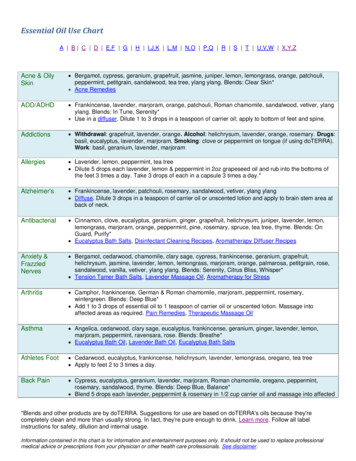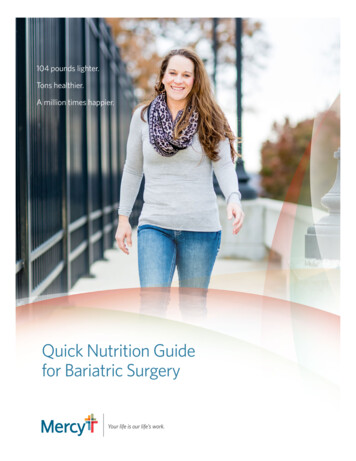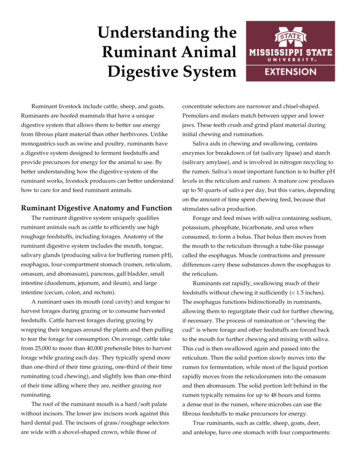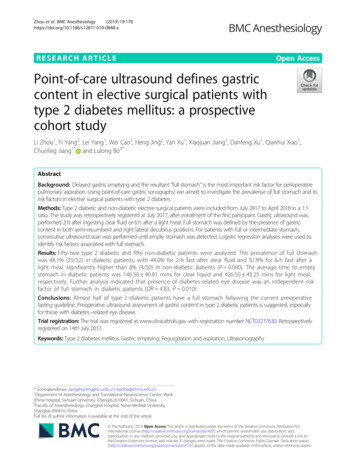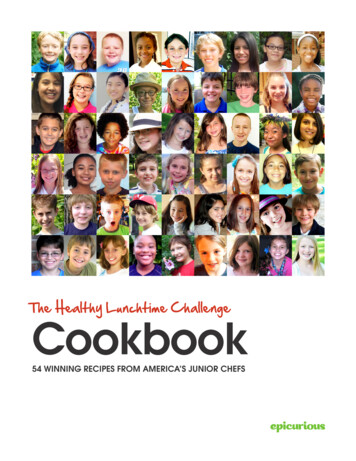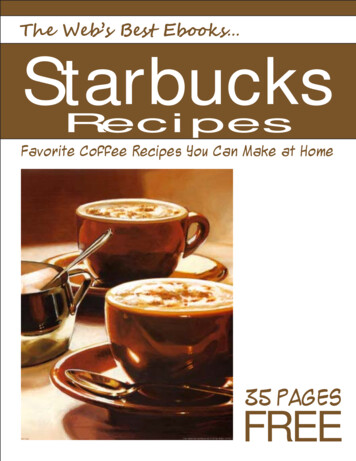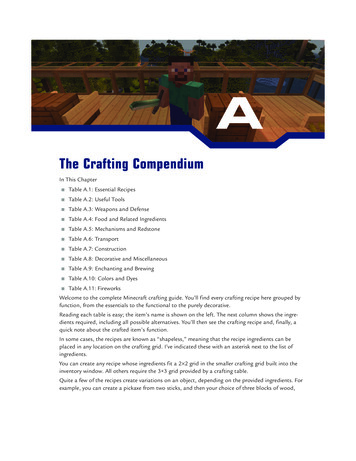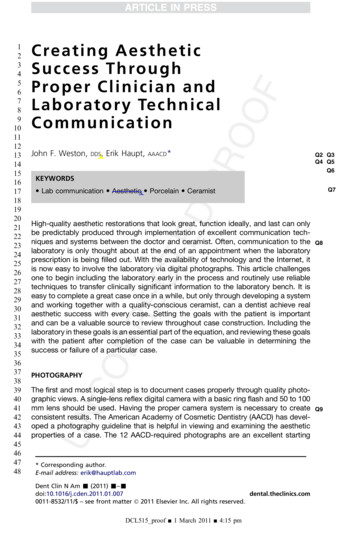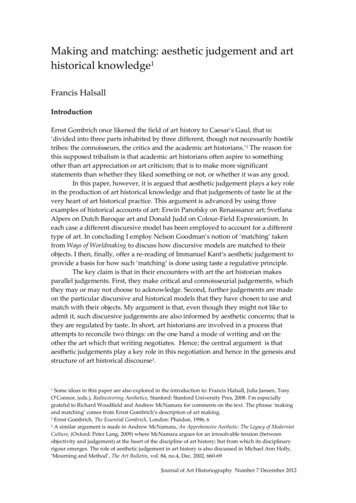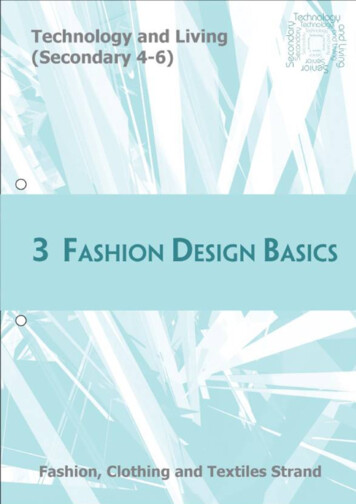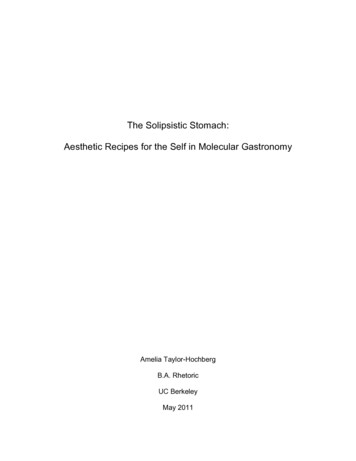
Transcription
The Solipsistic Stomach:Aesthetic Recipes for the Self in Molecular GastronomyAmelia Taylor-HochbergB.A. RhetoricUC BerkeleyMay 2011
Taylor-Hochberg 2AbstractIn 1988, the French physical chemist Hervé This began quantifying the aesthetic experience ofcuisine into an empirical formalism, a discipline he named “molecular gastronomy”. Throughcomparisons to food aesthetics in modern sculptural and performance art forms, this essayexamines how molecular gastronomy offers an isolationist, static philosophy of the self. Theessay will also criticize philosophical thought’s disparagement of taste as a conduit of aestheticexperience. As an alternative to molecular gastronomy’s formalism, this essay offers a relational,progressive model of solipsistic culinary aesthetics that encourages creative collaboration andinnovation.Keywords: molecular gastronomy, aesthetics, solipsism, taste
Taylor-Hochberg 3Table of ContentsINTRODUCTION: SATIATIATING THE AESTHETIC AND NUTRITIONAL APPETITE.5FOOD AND PHILOSOPHY: REPROACHING TASTE IN AESTHETICS .9HAVING THE CAKE BUT NOT EATING IT: KANTIAN DISINTERESTEDAESTHETICS. . .10THE CALF THAT WOULD BE VEAL: HEGEL AND ARTISTIC SELFCONSCIOUSNESS . .12CULTIVATING CONSCIOUSNESS: POST-HEGEL LOCALISM AND THEINDUSTRIAL STANDARD .13IN THE MOUTH OF THE BEHOLDER: TASTE EMPIRICISM ANDCATEGORIZATION . .16TOO MANY COOKS IN THE LABORATORY: MOLECULAR GASTRONOMY’SCULINARY FORMALISM .19CUISINE’S NATIVE LANGUAGE: DEVELOPING THE FOOD OBJECT’SDESCRIPTIVE FORMALISM . 24RECIPE FOR COPYRIGHTS: POST-THIS CULINARY CREATIVITY . .28OUT OF THE FRYING PAN AND INTO THE GALLERY: EDIBLE MATERIALS ANDUNSUSTAINABLE FOOD ART .30PRESENTATION AND CAPTURE: SPOERRI AND PROCESS ART .33THE RESTAURANT ALLEGORY: “THE HOLY PALATE” AND SYMBOLICMEALS .35CONCORDANCE, RELATIONS AND UTOPIA: ALLAN KAPROW, RIRKITTIRAVANIJA AND THE PERFORMANCE OF EATING .37THE BUSINESS OF THE SELF: ETHICO-AESTHETIC RESTAURANT DINING. .44
Taylor-Hochberg 4THE ALINEA MARK: ACHATZ AND THE AFFECTIVE FOCUS . .46DIGNIFYING THE QUOTIDIAN: A PROPOSED MODEL FOR FOOD AESTHETICS. .50
Taylor-Hochberg 5INTRODUCTIONSATIATING THE AESTHETIC AND NUTRITIONAL APPETITEThe affluent human omnivore has the luxury of choice when it comes to cuisine. Wheneating is considered a willful indulgence, rather than only a sustaining necessity, it becomes amalleable medium for creative interpretation, while also retaining its ability to perpetuate life.But cuisine, the stylized framework for what humans eat, is paid little attention in the history ofaesthetic theory because of its retained survivalist utility. Pragmatism is unavoidable in eating,and therefore its primary sensory mode, taste, receives a discounted aesthetic value. In her book,Making Sense of Taste: Food and Philosophy, Carolyn Korsmeyer judiciously and methodicallyexplains taste’s historical disrepute as a too-corporeal, too-subjective sense, and its subsequentexclusion from the evaluation of aesthetic objects considered as art. This certainly has notdiscouraged artists from using food in both plastic and representative forms, nor has itencouraged a utilitarian model of high cuisine. But food as art carries an undeniable potency,using materials that sustain life towards conceptual rather than solely functional ends. Rawmaterials are plucked from the earth and reconstructed through cooking to create an object thatinvites demolition through intended consumption. How does one evaluate an art form that, afterproduction is complete, is necessarily transformed through eating and then destroyed bydigestion? It is not the aim of this essay to convince the reader that cooking should be considereda “fine art”. The hope is simply to align food’s aesthetic qualities with its survivalistic ones, bothas strategies of self-formation. That being said, it is not my aim to argue for an aesthetics of“world cuisine” that assumes a single system of aesthetic value for food; given the variety inresources, value systems and societal norms, such generalization would run counter to thediversity of food cultures that exist in the world. To this end, the scope of food art and cuisineexamined will be limited to Europe and America from the twentieth century onward. A further
Taylor-Hochberg 6limitation of this analysis is that the food in question is willfully aestheticized because theparticular agents can afford it—that is, this is not a discussion of populist, purely functional orindustrially produced cuisine. The data is limited to subjects that consciously conflate art andfood, in explicit contexts of either art or cuisine.Notions of art and food converge with the arrival of “modernist cuisine”—an approach toeating that manipulates or disregards traditional cuisine practice in favor of a liberalized nonregional, non-cultural food object.1 A manifestation of this general practice, and the mainculinary focus of this discussion, has been termed “molecular gastronomy”, a reference to theempirical culinary studies conducted by French physicist Hervé This. The practice of moleculargastronomy, as distinguished from the cuisine of the same name, is a study of the chemicalproperties and transformations that compose certain food objects. The cuisine itself is not aproduct of This’ research: that it uses traditional laboratory equipment in its food productionbecame reason enough to conflate the culinary movement with This’ empiricism.2 As cuisine,molecular gastronomy establishes concrete aesthetic aims for the food object, but as a scientificdiscipline, it obsesses over empirical description. The goal of the science of moleculargastronomy is to provide an objective rubric for food evaluation through the creation of acommon, empirically descriptive language. By providing such a language, aestheticinterpretations of food could be formalized so as to mediate among the subjective experiences ofeating and thus establish a shared dialogue. This descriptive analysis of the aesthetic food objectthrough a formalized language ultimately seeks to control and contain that object, implying a1Lancaster, John. “Incredible Edibles: The Mad Genius of “Modernist Cuisine””, The NewYorker online edition.2Hervé This further explains molecular gastronomy’s differences and similarities to themovement in high cuisine in “Molecular Gastronomy, a Scientific Look at Cooking”.
Taylor-Hochberg 7linguistic ownership of creative production and a conception of art as somehow complete andseparate from the agent’s body.Molecular gastronomy’s formalism is essentially grappling with the anxieties that food inart raises: forcing the individual to confront the somatic mechanisms (digestion, excretion) thatoperate out of the control of the cognitive self. These autonomic processes are necessary forsurvival, and operate independently of the conscious will, in that they are indifferent to theindividual’s self-conceived identity. Identifying as vegetarian will not keep the stomach fromdigesting meat. The conflation of these two selves, the self-conscious and the somatic, becomesexplicit in the aesthetics of cuisine and the act of eating, as the passive, direct experience of tasteis translated into critical, cerebral interpretations of taste. Further complications arise from thesynesthetic qualities inherent to eating, that the taste experience is never purely separated fromvisual, tactile or olfactory stimuli. This substantiates another important distinction in thediscussion of food aesthetics: the approach and the encounter. The approach encapsulates allthat precedes the actual destructive consumption of the food object, including how it is designed,cooked and presented. The encounter begins at the mouth, at the juncture of integration with thebody. There is a sensorial rift between the approach and the encounter, from visual stimuli togustatory ones, but the approach’s affects inevitably bleed into the understanding of theencounter, as attention paid to visual and aural presentation can influence taste appreciation. Theconverse is true as well, as gustatory memory can guide future visual confrontations. Theencounter phase is what actively identifies the object as food, for food occupies a uniqueperformative capacity to become itself by being eaten. Such fluid realization of form furtherfrustrates the evaluation of food aesthetics, as it confuses the differentiation between object andsurroundings.
Taylor-Hochberg 8Straddling the rift between approach and encounter, aestheticized food forces aconfrontation between the self-conscious and somatic sides of the self, forming explicit phases ofa possibly dissonant identity and demanding that art be actively experienced through theindividual’s engagement. Food and eating embody the realization of the body in itself, as both awillfully analytical self and a mammalian body. While food aesthetics face a bias towardsunsustainable art forms that integrate object and individual, “the proof of the pudding is alwaysin the eating”3, as artistic evaluation only becomes possible once the object is activelyexperienced instead of passively observed. Food aesthetics exhibits the self in its examination ofself-conscious and somatic identity, and exposes how creative constructions of these twodomains through cooking render humanity’s sense of its own mortality.3Korsmeyer, Carolyn. Making Sense of Taste: Food and Philosophy, p. 43.
Taylor-Hochberg 9FOOD AND PHILOSOPHY: REPROACHING TASTE IN AESTHETICSIn the hierarchy of aesthetic senses, taste and its media, food, are given little credence.Wrapped up in the ordeal of the body and inextricable from daily life, food is an object ofperformance: not only involved with the ritual act of eating, a food may exist as simply the utilityto sustain life. An object becomes food only once it has been eaten, regardless of culture, flavor,organism or necessity. Understanding an object as food by the performance of consumptionmuddles the sense memory of the food object, forcing a conflation of before-eating and aftereating stimuli: how is the experience of the approach to the object related to the encounter ofactually eating? This realization process of the edible object as “food” is confused further by thenecessity of integration—once a thing becomes food, it also becomes part of the diner’s self,incorporated into the eater’s body. This corporeal integration necessary for the experience offood bewilders and distresses philosophical accounts of eating, and in general serves to discreditthe critical assessment of taste and food aesthetics.In particular, categorizing the body’s access to and integration of the world beyond thesomatic boundary, post-Enlightenment philosophical thought renders a strict hierarchy of thesenses. Sight is given the superior position without hesitation4, as it is the most qualified tovalidate and enact the central tenets of aesthetics discourse. Two philosophers who havedeveloped extensive theories on artistic appreciation and aesthetic evaluation are Immanuel Kantand Georg Wilhelm Friedrich Hegel, and their theories in respect to taste and eating will beexplained in regards to the devaluation of food as an aesthetic experience. While neither Kantnor Hegel could have possibly experienced the variety or elaborateness of modernist cuisine,4Korsmeyer, Carolyn. Making Sense of Taste: Food and Philosophy, p. 61.
Taylor-Hochberg 10both are concerned with the fundamental act of tasting: an integration of an object into the bodythat necessitates destroying it.HAVING THE CAKE BUT NOT EATING IT: KANTIAN DISINTERESTED AESTHETICSKant’s conceptualization of beauty as achieved through aesthetic means hinges upon thestrict and maintained separation between the self and the art object. Neither aestheticappreciation nor evaluation of beauty is valid when the individual is somehow physicallyinvolved with the object. By compromising the separation between the self and the object, theindividual’s perception will necessarily be skewed away from Vorstellung, or the “pure pleasurein the presentation of the object of perception”.5 Instating the necessity of presentation suggestsan incredibly strict definition of the art object based on containment—on the separation anddiscreteness of the individual and art piece. If there is any conflation between the subject andobject, then the interpretation of the art object is compromised and no longer “pure”. Maintainingdistance here preferences sight above all things, as the eye may observe from a variety ofperspectives without touching, while the physical contact necessary for gustatory sensationbreaks the contract of containment and separation. This theory then dignifies only half of theeating experience: the approach is evaluated, but the encounter is refuted and denied. Taste isgiven zero application in such a model, as its enactment (and the diner’s satiation) relies on thestimulus of flavor.This discreteness between person and object is what distinguishes the Beautiful from themerely agreeable (Kant’s binary). An object is agreeable when it is specific to the individual’s5Korsmeyer, Carolyn. Making Sense of Taste: Food and Philosophy, p. 55.
Taylor-Hochberg 11opinion6: some may find pickled cabbage delectable, others, revolting. The object attains the“beautiful” descriptor when it can provoke a pleasurable, subjective experience that nonethelessaligns itself towards a universal necessity,7 implying that if something is beautiful then thepleasure it creates should be universally accessible. Taste standards contingent upon culturaldiversity and biologically inheritable flavor preferences create very clear rifts between certaincuisines, and their accessibility to “universal necessity”. Regardless, the pleasure that thebeautiful kindles is created through an encounter of “disinterested pleasure”,8 evoking again thenecessary separation between the subject and object. The disinterest refers to the physical andtherefore critical distance that is necessary in reliably evaluating the spirit of an art object asopposed to its craft. Kant classes the gustatory as the absolute inferior on the hierarchy of senses,because it belongs to the “private and subjective” realm of the body, and therefore cannot evercome to claim “universal validity”9 amongst humanity. Evaluating an art object’s beauty has twophases: firstly, does it evoke a subjectively pleasurable experience, and secondly, can it do thisuniversally—can it infinitely produce a sense of pleasure despite subjective experiences. Tastingand eating cannot do this because it conflates these two phases and collapses the critical distancebetween individual and object: the tasting experience is also the pleasure object. In order toexperience the pleasure, the object must be subsumed entirely and irretrievably, forbidding thepossibility of universal appreciation of that single art object.6Korsmeyer, Carolyn. Making Sense of Taste: Food and Philosophy, p. 54-55.Ibid.8Ibid.9Delville, Michel. Food, Poetry and the Aesthetics of Consumption: Eating the Avant-Garde, p.1.7
Taylor-Hochberg 12THE CALF THAT WOULD BE VEAL: HEGEL AND ARTISTIC SELF-CONSCIOUSNESSThe essential precipitate of Kant’s Beautiful object, as distinguished from the merelyaesthetic, is a gap—a negative more than a positive necessity. Establishing a distinct separationbetween subject and object is necessary in order to preserve the artistic integrity of the object, aswell as the validity of the subject’s experience and interpretation. This physical distance isevoked but also transcended in Hegel’s discussion of the art object. Hegel’s argument accepts thesensory stimulation necessary in order to experience art, but asserts that art is ultimately aspiritual endeavor.10 The bargain is that through sensorial experience of an art object, the spiritwill become conscious of itself—that the art object will provoke a translation of bodily sensesinto spiritual consciousness. Eating as a gustatory-sensory experience is again, similarly toKant’s conclusion, disregarded as a valid art form because it does not fall in line with the twophase paradigm, of translating the physical/sensual into the spiritual/artistic. Food is necessarilydestroyed and integrated into the self when it is eaten, denying its potential as an art object.Eating and digestion fuse the subject-object distance necessary for artistic consideration, becausethey transform the externality of food into a “self-like unity”11, the interior enveloping theoutside.In conjunction with the prerequisite of critical distance, the concept of presentation is alsointegral to Hegel’s evaluation of the art object. The encounter with the art object is necessarilyan exhibition (similar to Kant’s Vorstellung) that preserves both critical distance and objectsingularity. In an important distinction, Hegel conceptualizes art as a presentation to the senses,1210Delville, Michel. Food, Poetry and the Aesthetics of Consumption: Eating the Avant-Garde, p.2.1112Ibid.Korsmeyer, Carolyn. Making Sense of Taste: Food and Philosophy, p. 60.
Taylor-Hochberg 13rather than a sensory action, placing agency upon the art object rather than the body. Aligningitself against the senses instead of within them, art becomes self-justifying, and exist for its ownsake,13 not to serve a practical or functional purpose (such as the necessity of eating to survive).Rather than fulfilling a pragmatic function, art is instead a casualty of what Hegel calls the“Spirit”: the ephemera of human life and the progress of living thought, manifested in the flux ofhuman culture.14 When this Spirit becomes conscious of itself through humanity, the product isart. This self-reflective consciousness alone would not necessarily exclude cuisine as art, ascultures are perpetuated and transported in part through synechdocal edible pieces—the festivalfood, the ritualistic dish, the seasonal treat. But Hegel excludes food in its natural incarnation(fruits, vegetables, grains, etc.) from art because nature is incapable of this self-consciousness15.CULTIVATING CONSCIOUSNESS: POST-HEGEL LOCALISM AND THE INDUSTRIALSTANDARDNature as completely without consciousness is, incredibly and disturbingly, no longerentirely true. What Hegel could not have possibly predicted is the pervasiveness of geneticmodification in consumer foodstuffs, and the market regulations that conform the aesthetics of acertain food to a legal standard. The demands and technical advancements of industrialagriculture have allowed producers to breed their crops selectively: to isolate, magnify andreproduce the most desirable aesthetic quality of the food for the market. The EuropeanEconomic Community, the 1958 precursor to the European Union, subjected twenty six fruitsand vegetables to a set of “uniform standardization parameters”, in an effort to facilitate cross13Korsmeyer, Carolyn. Making Sense of Taste: Food and Philosophy, p. 62.Ibid. p. 60.15Ibid.14
Taylor-Hochberg 14border trade by establishing a shared produce grading standard16. More often then not, thestandards have nothing to do with taste: they are entirely based on visible characteristics of thefruit or vegetable.17 This technique is a directly political one, responding to demands forfoodstuffs that show quality by their predictability, with minimal imperfections and maximizeddesirability. Certainly there is a distinction between food as art and food as a commodity, and inthis case the genetic engineering is justified by industrial standards of consumer products. Butundeniably, visual aesthetics are a concern and now that they have become malleable at thegenetic level, nature is no longer completely without a “consciousness”. It may be an enforcedconsciousness, one that bends to the will of popular demand, but it is no longer an unchangingconstant in the evaluation of food aesthetics.Even before the advents of the industrial grade, nature imbued its flora with the particularbiochemical characteristics of the earth in that specific, inimitable plot of land. The concept ofterroir (French for land or soil), originating in oenology, describes the effects that soil, topologyand climate have on the taste of a particular grape18. Extrapolated, terroir connotes locality,where the crop is an expression of its environment’s idiosyncrasies. The crop then begins toembody its unique flavor of place. Whether or not terroir is a strong enough quality to givenature a degree of Hegelian consciousness, it has become in some cuisines a desirable factor torival industrial uniformity. A certain crop can become prestigious because of its embodied place,bestowing a singularity upon the food and separating it from unfamiliar relatives, such is the casewith the particularly sweet Vidalia onion from the eponymous American Georgian city.19 Theisolated variable here is the specific origin space of the food, the derived pleasure and aesthetic16Westphal, Uli. “Edible Geography: The Mutato Archive”.Ibid.18Oxford English Dictionary Online, “terroir”.19New Georgia Encyclopedia Online, “Vidalia Onion”.17
Taylor-Hochberg 15value based on unique earthen expression rather than uniform predictability. This valorizedlocalism stands in direct opposition to the enforced national marketing standards as previouslylisted by the European Union or the United States’ Department of Agriculture20. In these cases,uniformity creates a reliable supply, and perpetuates a monotony of a supposed idealized foodform. In the case of terroir, an assertion of unique locale distinguishes one food form from thenext, establishing a physical-ecological identity as separate from its botanical other. Thisassertion of local personality bestows some glimmer of consciousness upon the land, questioningHegel’s assertion that nature lacks self-consciousness and is therefore incapable of creating art.The edible products of terroir or industrial agriculture are unquestionably manipulated aestheticobjects, but whether this qualifies them as expressions of the human “Absolute Spirit” isunlikely. However, the distinction between the natural and the man-made is increasingly blurredin Western, twenty-first century food economies21, convoluting the idealized form of naturalbeauty and desirability.20United States’ Department of Agriculture: Agricultural Marketing Service “Grading,Certification and Verification. April 30, 2008.21for more information on European produce standards see the art and website of Uli Westphal.
Taylor-Hochberg 16IN THE MOUTH OF THE BEHOLDER: TASTE EMPIRICISM ANDCATEGORIZATIONComplex standardizations have been developed in order to evaluate a food’s appearance,but such a rubric is harder to apply when it comes to actual flavor. How the sense of taste isunderstood is restricted to the harshly reductive paradigm of the five tastes: sweet, sour, salty,bitter and umami. The four classical tastes (excluding umami) are conceived in reference toclinical laboratory tests, far removed from the natural activity of eating. Scientific identificationof “tastes” involve flavor solutions administered so far back in the throat that the flavor does notstimulate the nasal passages, ensuring the pure “tasting” of the flavor excluded from aroma22.An encounter with a raw foodstuff is not simply a blend of these four (or five) flavors: instead,individual components of flavor interact differently depending on the food, producing a highlynuanced flavor that is more dynamic than accumulative23. In scientific evaluations of flavor, twofoods that may possess the same amount of quantified bitterness still express that bitterness asdifferent flavors—similar to how an flute’s timbre can distinguished it from a clarinet playing theexact same note. The classical four tastes are more helpful as reference points, rather thanflawless classifications, in how humans evaluate flavors24. The diction available to tasteevaluations is incredibly limited, and in no way indicative of the vast diversity of flavors that areedible.This reductionist scientific approach to the human experience of taste perpetuates aclumsy descriptive method that downplays the complexities of taste and flavor. Similar to22Further descriptions of how flavor scientists evaluate taste stimuli can be found in CarolynKorsmeyer’s Making Sense of Taste: Food and Philosophy. p. 76.23Korsmeyer, Carolyn. Making Sense of Taste: Food and Philosophy. p. 77.24Ibid. p. 77.
Taylor-Hochberg 17marketing strategies for consumer “health” products that reduce nutrition to the accumulation ofgood and bad things25, relying on a divisive framework of sense perception limits not only ourunderstanding of how taste works, but how we may aesthetically take charge of such a sense.Flavor evaluation is often skewed by visual perception, creating a cognitive dissonance betweenwhat flavor is expected and what is actually experienced: without the food coloring, Cheetostaste less cheesy26. Limiting the linguistic descriptors of food to a handful of tastes assumes thattasting lies entirely on the tongue, and is not a multi-sensory cognitive experience. Relying onthese rubrics to describe the pleasures derived from eating, and perhaps to eventually considerthe beauty of a food and its flavor, recalls an empirical model similar to John Locke’sconservative cognitive theory. Championing an accumulative empiricism of experience, Lockecountered the Cartesian assumption of innate qualities and pushed an experiential approach toknowledge: all human thought was to be culled from the outside world, through the sensoryorgans of the body27. New ideas are simply more complex reconfigurations of an accumulationof simple data from the physical environment, resulting from further mental operations orreflections. Locke’s conceptualization of ideas and creativity is symbolically molecular: that outof a handful of simple forms (atoms), the brain may configure ideas (molecules). But this doesnot explain the potency of the actual connection—how these ideas are put together and whatholds them that way. This rejected dynamism in favor of a two-dimensional accumulative modelsurfaces in the restrictive four-flavor standard. The conservation of forms becomes particularlyproblematic in the form of cuisine, as a creation to be understood by composition but also edibleexperience: appreciating form and application. As a performative, pragmatic and unsustainable25for more data on the reductionist nutritional philosophy, see Michael Pollan, In Defense ofFood.26More information on the affect of perceived color on taste sensation can be found in“Colorless Food? We Blanche”, Gardiner Harris, NY Times, April 2, 2011.27Korsmeyer, Carolyn. Making Sense of Taste: Food and Philosophy. p. 46.
Taylor-Hochberg 18object, food is discredited from the philosophical realm of art, but is nonetheless a humanisticand cultural entity worthy of aesthetic discourse.
Taylor-Hochberg 19TOO MANY COOKS IN THE LABORATORY: MOLECULAR GASTRONOMY’SCULINARY FORMALISMAn explicit appeal to the classical arts is not this discussion’s prerogative for the mostpart, but the world of so-called “modernist cuisine” has recently been butting its head against aset of fine-art comparisons, embodying the modernist ethos of “a rupture within the history of theart form”.28 Chefs that employ a slew of technological innovations in order to innovate andeconomize their edible productions rely on scientific techniques that are in no way exclusivelyculinary, but still distinguish them as “modernist” chefs. Often, these newly enfranchised tools ofthe kitchen are borrowed from the chemical laboratory, an influence neatly encapsulated by theproverbial label of “molecular gastronomy”. This term conveniently hybridizes the environmentsof the laboratory and the kitchen, but it has been highly convoluted in the public eye by thepopular press and prematurely attached to chefs who have no faith in the term as it reduces theirdishes to “scientific party tricks”.29 It is also in no way a modern concept: all cooking somehowtransforms a food object’s molecular composition, so there is no such thing as specifically“molecular” cuisine. Such interest in “kitchen science” surfaced in the 1960s, with the likesNicholas Kurti, a French specialist in low-temperature physics, lecturing on the effects of heatsources on soufflés.30 The term “molecular gastronomy” is not a style of cuisine, but an isometricembodiment of study and practice: it describes the molecular-chemical qualities of a dish, as wellas how these qualities may be harnessed to create new food objects.28Lancaster, John. “Incredible Edibles: The Mad Genius of “Modernist Cuisine.”” The NewYorker, online edition.29Ibid.30Ibid.
Taylor-Hochberg 20The former component of molecular gastronomy, as a study of the chemical technicalitiesof cooking, is the main concern of Hervé This, a colleague of Kurti and French physical chemist.This credits himself with the coinage of “molecular gastronomy” in 198831 and has writtenhandfuls of books and articles on the subject, as a way to dissect and evaluate the processes thatcook food on as precise a level as possible: in the epistemological tradition of quantitativerationalism, this boils down to the molecular. This is less concerned with developing cuisinesbased on the science of molecular gastronomy: his attention is focused on precision andrepetition, understanding the make-up of the food object on the most scrupulous scientific level,not managing a restaurant.Molecular gastronomy as a discipline arises from the tradition of methodologicallaboratory science, as This explicitly states in his constructivist approach to cooking, Building AMeal. A collection of
industrially produced cuisine. The data is limited to subjects that consciously conflate art and food, in explicit contexts of either art or cuisine. Notions of art and food converge with the arrival of “modernist cuisine”—an approach to eating that manipulates or disregards traditional
